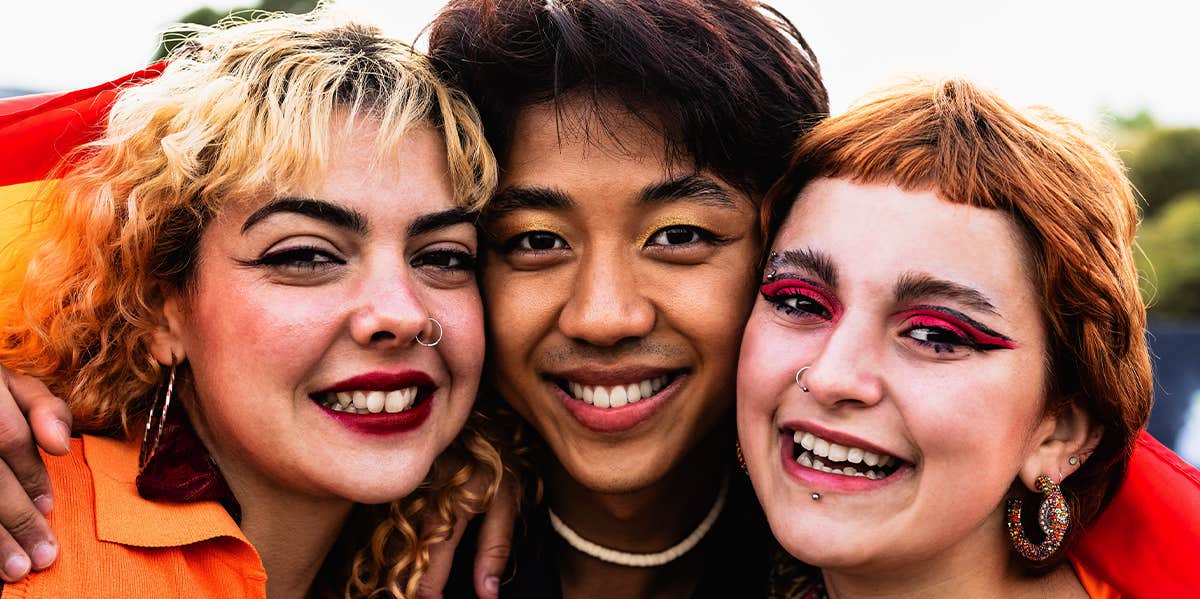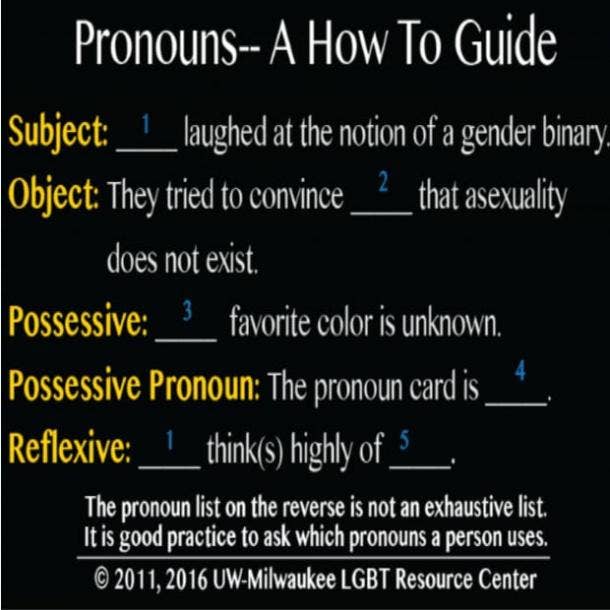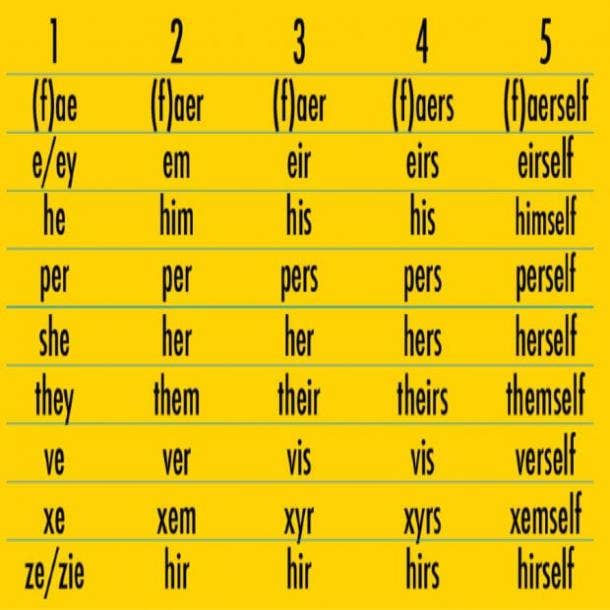
Lack of representation in the media doesn't mean you're not normal.
By Amber Leventry — Last updated on Sep 15, 2022
Photo: AlessandroBiascioli / Shutterstock

A person’s identity is so much more than a name scribbled on a "Hello My Name Is" sticker.
We are each complex beings made up of our histories, emotions, desires, and values, and defined by our sexual orientation, gender identity and gender expression, which is why the number of genders is finally being recognized as more than the basic two, male or female.
Like humans ourselves, conversations around the spectrum of gender and human sexuality are constantly evolving. It's becoming more common to see the option of “other” or “preferred” as choices when selecting a gender group and pronouns on registration forms.
To many of us in the LGBTQIA+ community, asking about our preferences — really, asking who we are — feels refreshing, even hopeful. It makes us feel respected and seen.
But for others, it raises some big questions.
How many genders are there?
There’s only one good answer to the question of how many genders there are: Gender is a spectrum, an umbrella term, and there are as many gender definitions as there needs to be for every person to have a label that lets them feel true to themselves.
Maybe that’s confusing. Let me explain.
There are three distinct and independent pieces of who we are — gender identity, sexual orientation, and gender expression. Each component depends on the other. They weave in and out, touching and layering on themselves to form a complete identity.
Happy #NationalComingOutDay! If you're unsure if coming out is right for you, take a look at our coming out guide: https://t.co/kxvoGYDG4Z pic.twitter.com/zHNqX9JxMy
— The Trevor Project (@TrevorProject) October 11, 2017
RELATED: How Transgender Women Of Color Led The Gay Liberation Movement In The Stonewall Riots
How do we proudly display all of our components in safe and meaningful ways to strangers if there isn’t room to include more than a name?
We do it by making room in our society for identities that do not follow the heteronormative assumptions of what is "normal." This may mean that we need to get a little uncomfortable while we learn about people and terms that are new or confusing.
Think of identity — the sense of self — as a spectrum with unlimited possibilities. The first thing we either attach to or reject is our gender identity — that sense of being male, female, neither, or both.
Scientifically, most believe that there are only two sexes that create a gender binary, which is based on the biological sex that you are assigned at birth. But there are over 64 terms that can express identity.
What is gender identity?
When humans are born, they are given a gender assignment based on sexual anatomy. That assignment is usually limited to only two genders: male or female.
Even babies who are born intersex — "a general term used for a variety of conditions in which a person is born with a reproductive or sexual anatomy that doesn’t seem to fit the typical definitions of female or male" — are given a gender assignment with the assumption that one needs a binary label.
But the label is just a suggestion, because sexual anatomy (traditionally used to define sex and gender in terms of identification) does not equal gender, as gender norms are changing and aren't limited to meaning only one or the other.
Gender is not the binary constraint of being a man or woman, boy or girl.
While I can’t tell you how many genders there are exactly, there definitely are more than two.
It might help if you understand a little about my personal history. Based on my anatomy, I was assigned female at birth. But since I was a kid, I knew I wasn’t just a girl. And as I got older, I knew I wasn’t a boy, either. I am both.
Once I discovered the language for this, I knew the word to describe me was nonbinary.
To identify as nonbinary means can’t be placed into a box of being either male or female, though, trust me, it would be easier to do this at times. The world is not a kind place for those of us who know one of the key components of our identity is a gender many people and organizations do not recognize.
RELATED: The Disturbing Reason Straight Men Are So Against Gender-Neutral Parenting
List of Terms for Gender Identity & Orientation
Agender
A term for someone who doesn't identify with any gender. Note that this is not associated with being asexual.
Androgynous
This is a term for someone who is gender-neutral and has both masculine and feminine characteristics presented.
Bicurious
The term bicurious is used for someone who has sexual relations with one gender but is curious about sex with a different gender.
This term is also used for people who identify as heterosexual but are curious about what it would be like to have a sexual experience or relationship with someone of the same sex.
Bigender
Bigender is a term for someone who identifies with two distinct genders, though not necessarily in a perfect 50/50 kind of split.
Cisgender
If your gender assignment at birth aligns with your gender identity, you are cisgender, sometimes abbreviated to "cis." Being referred to by this label is not an insult; it’s simply a way to describe the fact that your assigned gender matches your true identity.
Note that the words transgender and cisgender are adjectives — not good or bad, just descriptors of gender.
Cishet
Cishet is a term that is short for "cisgender heterosexual." This term is used to identify people who are both straight and cis.
Demisexual
Demisexual is a term describing someone who needs an emotional bond with someone to feel sexual attraction. "Demi" is also an umbrella term for some nonbinary gender identities.
These individuals use the prefix "demi-" to indicate that they partially identify with a particular gender. For example, they would call themselves demigirl, demiboy, and so on, because they only identify with that specific gender as half of them.
Femme
A femme is someone who is hyper-feminine. Most femmes do not identify themselves as women, while some do, but this label has nothing to do with the gender or sex assigned to them at birth.
A femme is someone who expresses their gender and experiences but does not express anything that would point to their biological sex.
Gender expression
Gender expression is how we want to show the world who we are.
As long as it doesn’t hurt anyone, we all have the right and gender option to do what makes us most comfortable and happy. This includes what we wear, how we style our hair, if we wear makeup or jewelry, the names and pronouns we want to be called, and how we accessorize any other external aspects of ourselves.
For example, someone may not be male, but express themselves in a masculine way. Others consider themselves trans masculine, even androgynous at times. Others express themselves in more feminine or femme ways; all genders can consider themselves masculine, feminine, neither, or both.
Genderfluid (or Genderqueer)
Some folks who don’t identify as either male or female may call themselves genderfluid or genderqueer. A genderfluid person is someone who feels male one day, maybe one hour, and female the next. Their gender fluctuates, but what’s consistent is that they are not always one or the other.
Genderqueer folks may identify as neither or both male and female, much like a nonbinary person, and their gender expression may fluctuate, breaking stereotypical gender expressions of what it means to be masculine or feminine.
Gender nonconforming
Some expressions, like a man wearing dresses, are considered gender non-conforming. For example, a person might identify as female, but describe their gender expression as masculine.
Gender dysphoria
Gender dysphoria is a medical diagnosis and term used to label someone who is struggling with their feelings, and as a way to communicate that they are in distress when it comes to their gender.
Medical diagnosis indicates a conflict between how a person feels about their sex assigned at birth, and the gender in which they identify.
Gender transition
This is the process of changing one's sex characteristics and/or gender presentation to match what someone believes their gender identity to be on the inside.
Gender normative
The term gender normative describes gender identities and traits that are understood to be accepted by social norms and expectations.
Heterosexism
This is the discrimination or prejudice held against someone who is heterosexual. It's based on the belief that heterosexuality is the only way one should express their gender identity because it's the only "normal" and "natural" way.
Homophobia
Homophobia is prejudice or dislike for someone who is attracted to a person of the same gender. Homophobia is often rooted in the fear of becoming homosexual, having repressed feelings for someone of the same gender, or psychological issues.
Intersex
Intersex is an umbrella term used to identify those who are born with the sex characteristics of both male and female genitalia. Their genitalia doesn't "fit the typical definitions for male or female bodies."
Metrosexual
Metrosexual is a term that encompasses young heterosexual men who are focused on their appearance and have an interest in fashion.
Non-binary (or Pangender)
Those who don't identify as either male or female, identify as being nonbinary. This person would appear to be sexually dimorphic.
Outing
"Outing" someone is the act of revealing their homosexuality, often without their consent.
Pansexual
Pansexuality describes someone who is on the nonbinary gender spectrum, and who is solely attracted to someone's personality, not their biological sex or gender identity.
Passing
Another term for "blending," passing is used to describe a transgender person who appears cisgender, rather than of the sex they were given at birth.
Queer
Queer is a term used to describe gender and sexual identities that are different than straight or cis. People who are queer identify as lesbian, gay, bisexual, and transgender.
Same-gender loving
This is a term used by African Americans to describe bisexuals and homosexuals.
Sexual orientation
A person's sexual orientation is defined by the gender(s) they are sexually attracted to.
Sex assigned at birth
At birth, medical professionals assign particular sex to a person based on their chromosomes, hormones, internal and external reproductive hormones, and their secondary sex characteristics.
Skoliosexual
A skoliosexual is someone who is attracted to people who are transgender or nonbinary.
Third gender
Being the third gender refers to a category that originated in the native and non-Western cultures to identify people who have a gender that is not solely categorized as male or female. These individuals are neither men nor women.
Transgender
If your gender assignment at birth does not match your gender identity, you are transgender, sometimes abbreviated to "trans." Many transgender people still fall into the binary of being male or female.
For example, a woman who was assigned male at birth based on anatomy knows she is a woman because of that inner sense of self. Therefore, she is a transgender woman.
RELATED: Why Misgendering Me Makes Me Feel Like My Body Is A Problem
How do I know what my gender is?
Well, how do you know if you are male or female? You just know — I do, too.
On most days I feel like a perfect mix of being both male and female; it’s a grounded feeling of knowing I am a hybrid of two genders. On other days, I don’t feel overly connected to any gender.
I am just me, but male pronouns are not right and female pronouns hurt. Because of this, I use they/them pronouns.
Related Stories From YourTango:
There are other options for gender-neutral and inclusive pronouns, and it’s anyone’s right to use the pronouns that make them feel most comfortable.

 Photos: UWM Lesbian, Gay, Bisexual, Transgender Resource Center
Photos: UWM Lesbian, Gay, Bisexual, Transgender Resource Center
While it may seem confusing at first, you don’t have to “get it” to respect it.
In some countries and cultures, the people who know they are neither completely male nor female are celebrated. In the United States, it’s hard for people to even get my pronouns correct, so I'm not expecting mass celebrations.
But for those who want to become better educated about the spectrum of gender orientation and identity, there are some important gender terms and definitions to know.
Why does gender identity matter?
Gender identity matters because it helps teenagers and children know that gender fluidity is a part of everyone's experience finding their sexuality and gender expression.
If a person doesn't learn about gender fluidity then they also might struggle with their mental health from gender dysphoria as a result of not being able to learn who they are and find their gender identity.
The important thing to remember is that there isn’t one way or a right way to be a man, woman, or nonbinary person, or gender fluid.
It’s a bummer to feel like we are constantly compared to what many think is the “normal” way men and women and male and female-bodied people should present themselves from the social construction of gender in our society.
Just because I am not represented in the media, movies or books, that doesn’t mean I am not normal. I am unique, perhaps. I am part of a minority. But I am normal and want pretty normal things in life and from others.
I want respect, kindness, and happiness. I want to feel safe and loved (because I fall in love, too).
My sexuality is an important part of who I am because it attracts people who see me for who I am. And for me, I want to find intimacy in vulnerable places with people who don’t question my identity.
The world can be pretty lonely for folks like me who are considered outliers. What makes me feel most at home and sure of myself can make others feel uncomfortable. My sense of self includes a gender outside of the binary, but my need for acceptance and compassion falls well within the range of deserved human decency.
What I really want is to feel more comfortable, and that can start with you.
Let go of assumptions and trust that the person you are talking to knows themselves better than what you think you know about them based on stereotypes and heteronormative thinking.
And when you add your name to that "Hello My Name Is..." sticker, add your pronouns, too. It shows that you don’t want anyone making assumptions about you and that you are happy to acknowledge any and all pronouns of the people who may be in your presence.
Hi, my name is Amber. I use they/them pronouns. I am a person who deserves kindness and respect.
There’s a lot to who I am. For instance, I like tacos and books and I want good coffee and great friends. And when we meet, I want to know what pronouns you use because I want you to feel good, too, while we search for the nearest library or taco truck together.
RELATED: 8 Rules My Parents Had That Made Me Comfortable With My Sexuality
More for You:
Amber Leventry is a queer, nonbinary writer and advocate. Amber’s writing has appeared on The Washington Post, Ravishly, Longreads, PopSugar, and The Temper, and they are a staff writer for Scary Mommy. Follow them on Twitter or visit their website for more.
